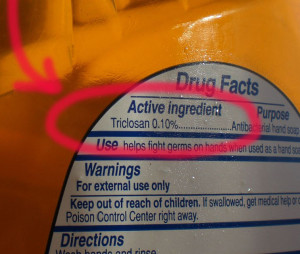
Example of a product label showing triclosan as an active ingredient.
Everyday household products we all use for cleaning and personal care could be hazardous to our health and to our environment if they contain triclosan. Triclosan is a common ingredient in a lot of commonly used products, such as antibacterial soap, toothpaste, body wash, deodorant, kitchenware and more. Triclosan has been shown to reduce muscle function, and in a University of California study on rats, a dose of triclosan to mice decreased heart muscle function by 25% and grip strength by 18%. In fish, a dose of triclosan equivalent to what would accumulate in one week in the wild decreased swimming performance.
Triclosan also affects hormones. It affects the body’s responses to estrogen, and many other chemicals that imitate estrogen have been known to increase risk of breast cancer. A study on frogs also indicated that even at extremely low levels (.15 ppb), triclosan disrupts hormone signals and decreases hormone levels from the thyroid. Triclosan could also contribute to the development of antibiotic-resistant germs that harm the human immune system. It is often disposed of through municipal drains, and thus contaminates water systems and aquatic ecosystems.
Triclosan has no benefits to the effectiveness of most products that contain it, and research has shown there are no real benefits to using antibacterial soaps over plain soaps. A 2013 University of Minnesota study identified triclosan in freshwater Minnesota lakes, and since then Minnesota has ban the sale of products containing the toxin. Other research has identified triclosan in New York’s waterways, which is why the NYLCV is working hard to push New York to follow Minnesota’s example to ban sale of Triclosan in our own state. In the meantime, we strongly recommend checking the labels and reading the ingredients of household products to decrease exposure and the potentially harmful effects to ourselves and our environment.
Resources for avoiding triclosan
- Beyond Pesticides has a list of common household products containing triclosan and also a list of companies that have signed a pledge to stop using and selling products with triclosan.
- Another great resource for finding safe products is the Environmental Working Group’s Skin Deep Database.
- If you’re unsure whether a product contains triclosan or not, check the label. Because triclosan is an active ingredient, it will be listed in the “drug facts” box on any product, according to the FDA.
- Also look out for, triclosan’s chemical cousin triclocarban.
- Avoid products that are labelled “antibacterial,” or make claims such as “odor-fighting” or “keeps food fresher, longer.”
